Page 97 of 106
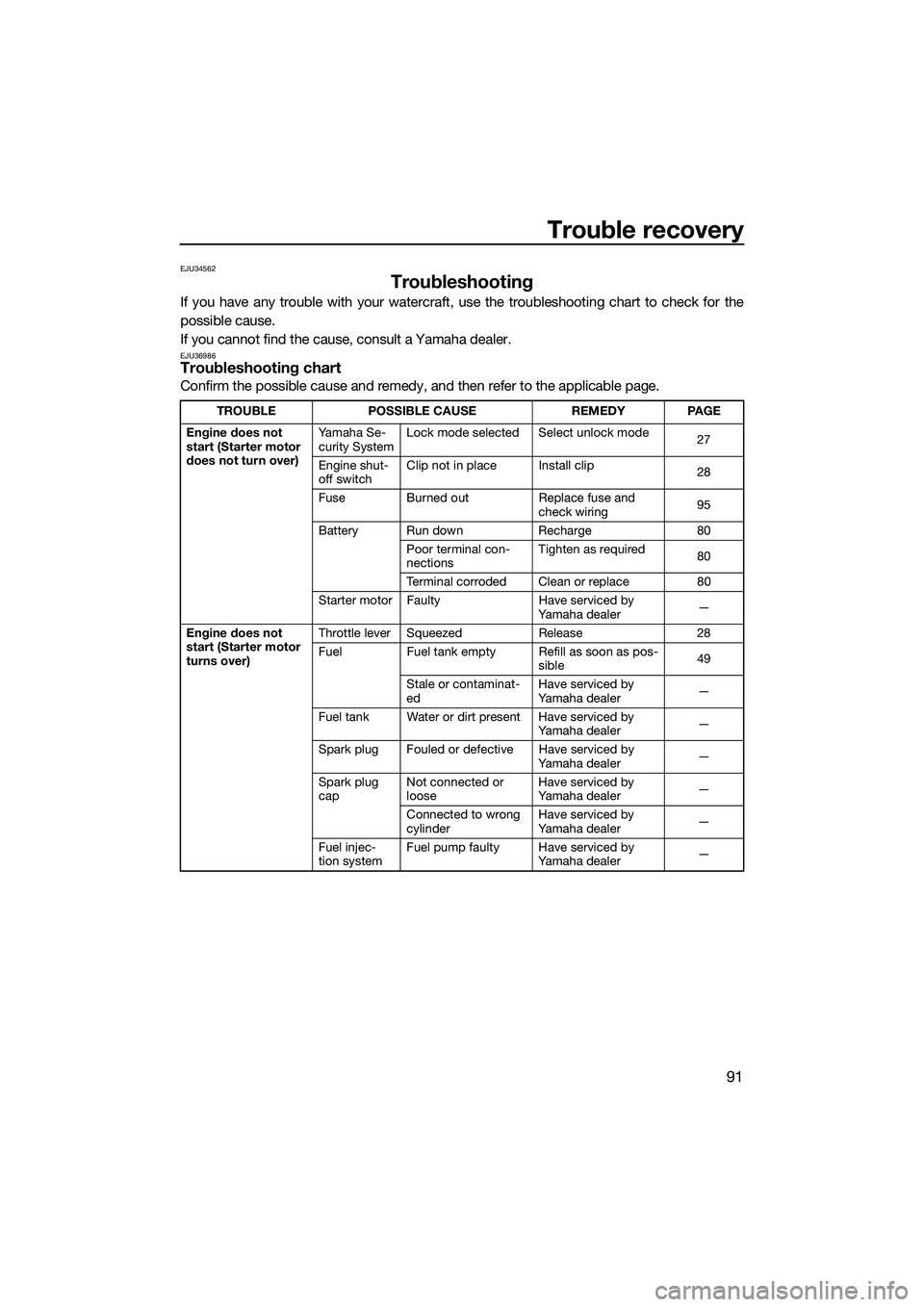
Trouble recovery
91
EJU34562
Troubleshooting
If you have any trouble with your watercraft, use the troubleshooting chart to check for the
possible cause.
If you cannot find the cause, consult a Yamaha dealer.
EJU36986Troubleshooting chart
Confirm the possible cause and remedy, and then refer to the applicable page.
TROUBLEPOSSIBLE CAUSE REMEDYPAGE
Engine does not
start (Starter motor
does not turn over) Ya m a h a S e -
curity System
Lock mode selected Select unlock mode
27
Engine shut-
off switch Clip not in place Install clip
28
Fuse Burned out Replace fuse and
check wiring 95
Battery Run down Recharge80
Poor terminal con-
nections Tighten as required
80
Terminal corroded Clean or replace 80
Starter motor Faulty Have serviced by
Yamaha dealer —
Engine does not
start (Starter motor
turns over) Throttle lever Squeezed
Release28
Fuel Fuel tank empty Refill as soon as pos-
sible 49
Stale or contaminat-
ed Have serviced by
Yamaha dealer
—
Fuel tank Water or dirt present Have serviced by Yamaha dealer—
Spark plug Fouled or defective Have serviced by Yamaha dealer—
Spark plug
cap Not connected or
loose Have serviced by
Yamaha dealer
—
Connected to wrong
cylinder Have serviced by
Yamaha dealer
—
Fuel injec-
tion system Fuel pump faulty Have serviced by
Yamaha dealer —
UF3K71E0.book Page 91 Monday, August 18, 2014 2:54 PM
Page 98 of 106
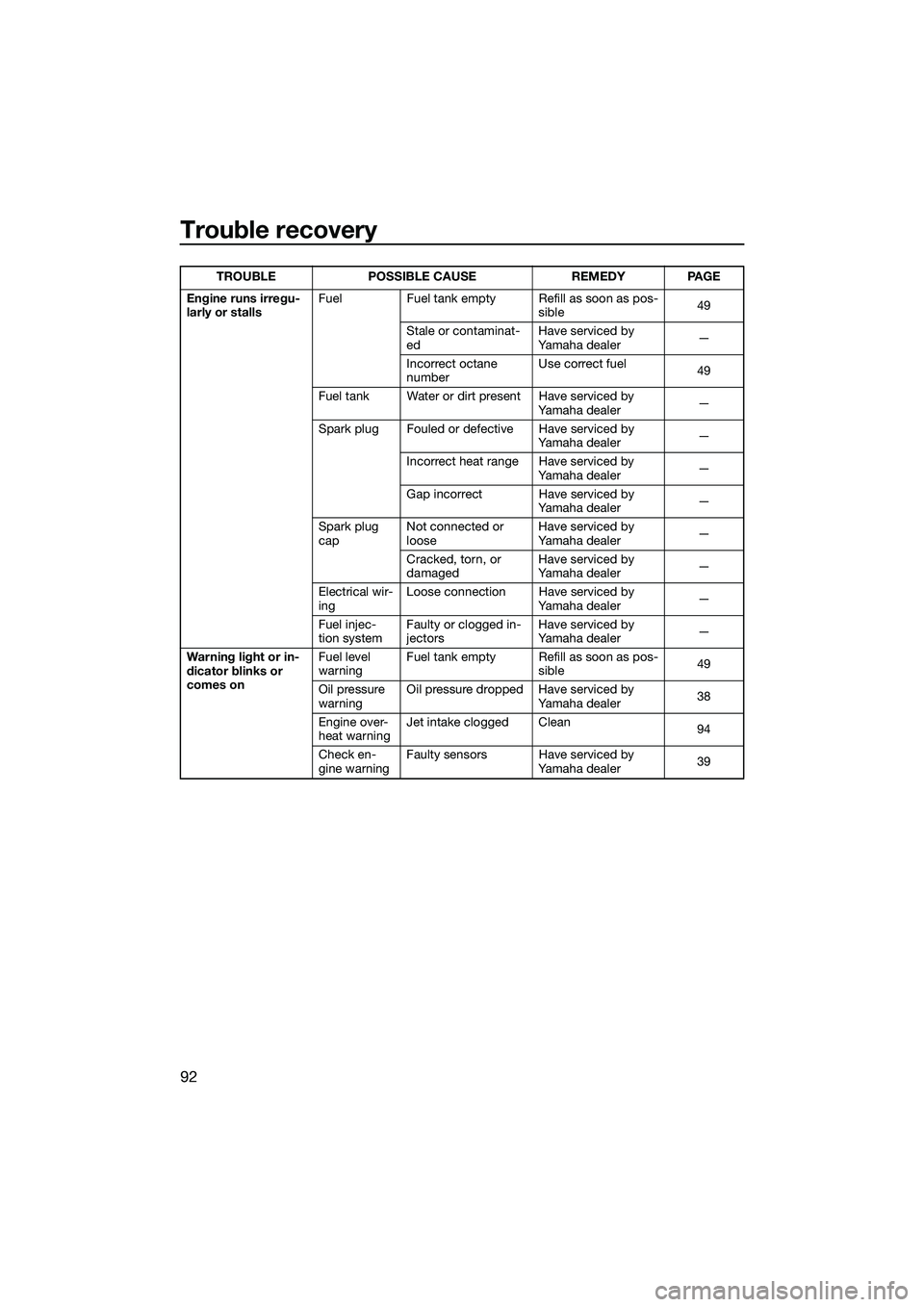
Trouble recovery
92
Engine runs irregu-
larly or stallsFuel Fuel tank empty Refill as soon as pos-
sible49
Stale or contaminat-
ed Have serviced by
Yamaha dealer
—
Incorrect octane
number Use correct fuel
49
Fuel tank Water or dirt present Have serviced by Yamaha dealer—
Spark plug Fouled or defective Have serviced by Yamaha dealer—
Incorrect heat range Have serviced by Yamaha dealer —
Gap incorrect Have serviced by Yamaha dealer —
Spark plug
cap Not connected or
loose Have serviced by
Yamaha dealer
—
Cracked, torn, or
damaged Have serviced by
Yamaha dealer
—
Electrical wir-
ing Loose connection Have serviced by
Yamaha dealer —
Fuel injec-
tion system Faulty or clogged in-
jectors Have serviced by
Yamaha dealer
—
Warning light or in-
dicator blinks or
comes on Fuel level
warning
Fuel tank empty Refill as soon as pos-
sible 49
Oil pressure
warning Oil pressure dropped Have serviced by
Yamaha dealer 38
Engine over-
heat warning Jet intake clogged Clean
94
Check en-
gine warning Faulty sensors Have serviced by
Yamaha dealer 39
TROUBLE POSSIBLE CAUSE REMEDY PAGE
UF3K71E0.book Page 92 Monday, August 18, 2014 2:54 PM
Page 99 of 106

Trouble recovery
93
Watercraft slow or
loses powerShift lever Not completely shift-
ed into forward posi-
tion Push lever forward
until it stops 32
Watercraft
operation
mode Low RPM Mode acti-
vated
Deactivate Low RPM
Mode 34
Cavitation Jet intake clogged Clean 94 Impeller damaged or
worn Have serviced by
Yamaha dealer
94
Engine over-
heat warning Engine speed reduc-
tion control activated Clean jet intake and
cool engine
39
Oil pressure
warning Engine speed reduc-
tion control activated Add oil
38
Spark plug Fouled or defective Have serviced by Yamaha dealer—
Incorrect heat range Have serviced by Yamaha dealer —
Gap incorrect Have serviced by Yamaha dealer —
Spark plug
cap Not connected or
loose Have serviced by
Yamaha dealer
—
Electrical wir-
ing Loose connection Have serviced by
Yamaha dealer —
Fuel Stale or contaminat- ed Have serviced by
Yamaha dealer
—
Incorrect octane
number Use correct fuel
49
Air filter Clogged Have serviced by Yamaha dealer—
Oil buildup Have serviced by Yamaha dealer —
TROUBLE POSSIBLE CAUSE REMEDY PAGE
UF3K71E0.book Page 93 Monday, August 18, 2014 2:54 PM
Page 100 of 106
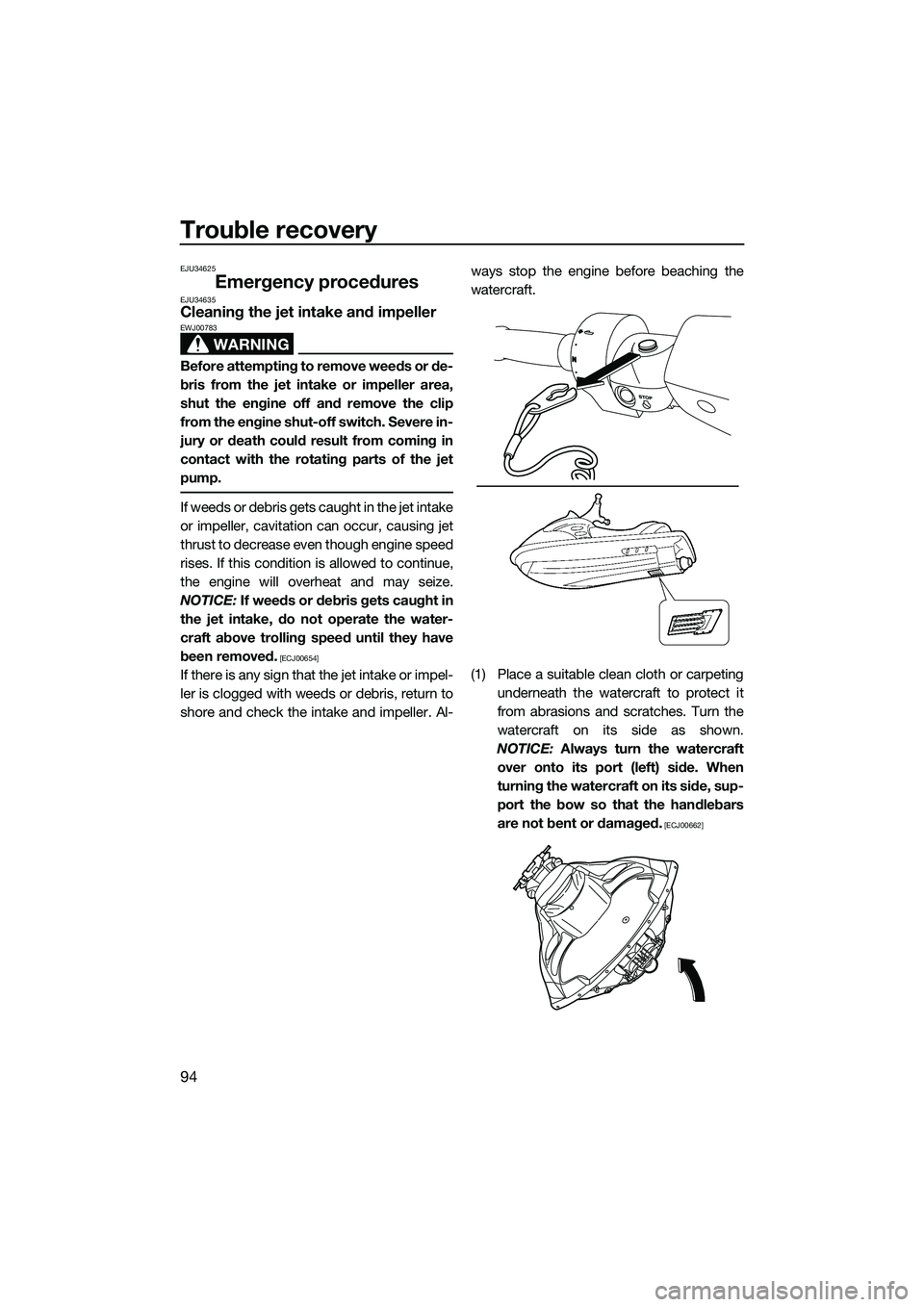
Trouble recovery
94
EJU34625
Emergency proceduresEJU34635Cleaning the jet intake and impeller
WARNING
EWJ00783
Before attempting to remove weeds or de-
bris from the jet intake or impeller area,
shut the engine off and remove the clip
from the engine shut-off switch. Severe in-
jury or death could result from coming in
contact with the rotating parts of the jet
pump.
If weeds or debris gets caught in the jet intake
or impeller, cavitation can occur, causing jet
thrust to decrease even though engine speed
rises. If this condition is allowed to continue,
the engine will overheat and may seize.
NOTICE: If weeds or debris gets caught in
the jet intake, do not operate the water-
craft above trolling speed until they have
been removed.
[ECJ00654]
If there is any sign that the jet intake or impel-
ler is clogged with weeds or debris, return to
shore and check the intake and impeller. Al- ways stop the engine before beaching the
watercraft.
(1) Place a suitable clean cloth or carpeting
underneath the watercraft to protect it
from abrasions and scratches. Turn the
watercraft on its side as shown.
NOTICE: Always turn the watercraft
over onto its port (left) side. When
turning the watercraft on its side, sup-
port the bow so that the handlebars
are not bent or damaged.
[ECJ00662]
UF3K71E0.book Page 94 Monday, August 18, 2014 2:54 PM
Page 101 of 106
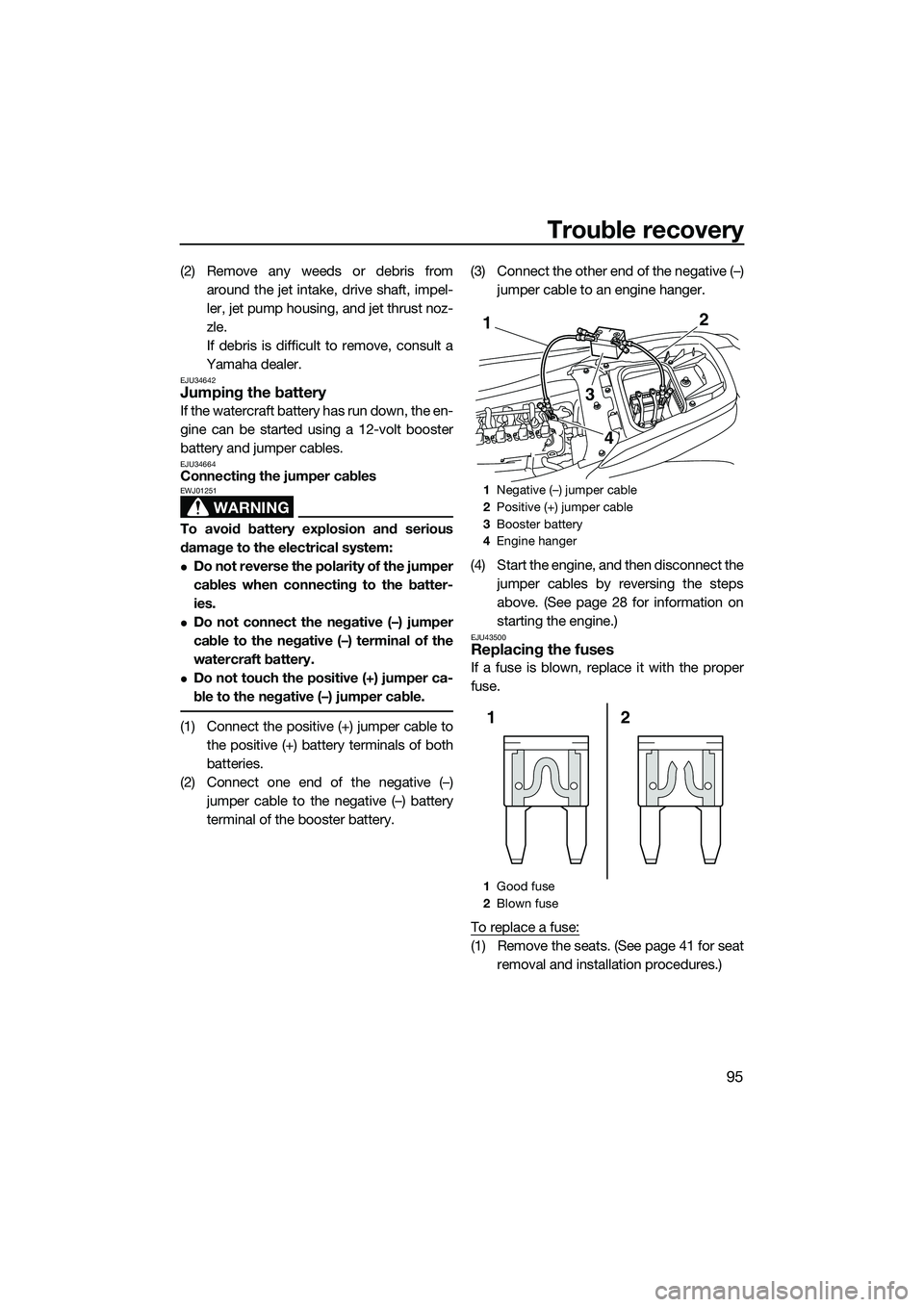
Trouble recovery
95
(2) Remove any weeds or debris fromaround the jet intake, drive shaft, impel-
ler, jet pump housing, and jet thrust noz-
zle.
If debris is difficult to remove, consult a
Yamaha dealer.
EJU34642Jumping the battery
If the watercraft battery has run down, the en-
gine can be started using a 12-volt booster
battery and jumper cables.
EJU34664Connecting the jumper cables
WARNING
EWJ01251
To avoid battery explosion and serious
damage to the electrical system:
Do not reverse the polarity of the jumper
cables when connecting to the batter-
ies.
Do not connect the negative (–) jumper
cable to the negative (–) terminal of the
watercraft battery.
Do not touch the positive (+) jumper ca-
ble to the negative (–) jumper cable.
(1) Connect the positive (+) jumper cable to the positive (+) battery terminals of both
batteries.
(2) Connect one end of the negative (–) jumper cable to the negative (–) battery
terminal of the booster battery. (3) Connect the other end of the negative (–)
jumper cable to an engine hanger.
(4) Start the engine, and then disconnect the jumper cables by reversing the steps
above. (See page 28 for information on
starting the engine.)
EJU43500Replacing the fuses
If a fuse is blown, replace it with the proper
fuse.
To replace a fuse:
(1) Remove the seats. (See page 41 for seatremoval and installation procedures.)
1Negative (–) jumper cable
2 Positive (+) jumper cable
3 Booster battery
4 Engine hanger
1 Good fuse
2 Blown fuse
2
3
1
4
2
1
UF3K71E0.book Page 95 Monday, August 18, 2014 2:54 PM
Page 102 of 106
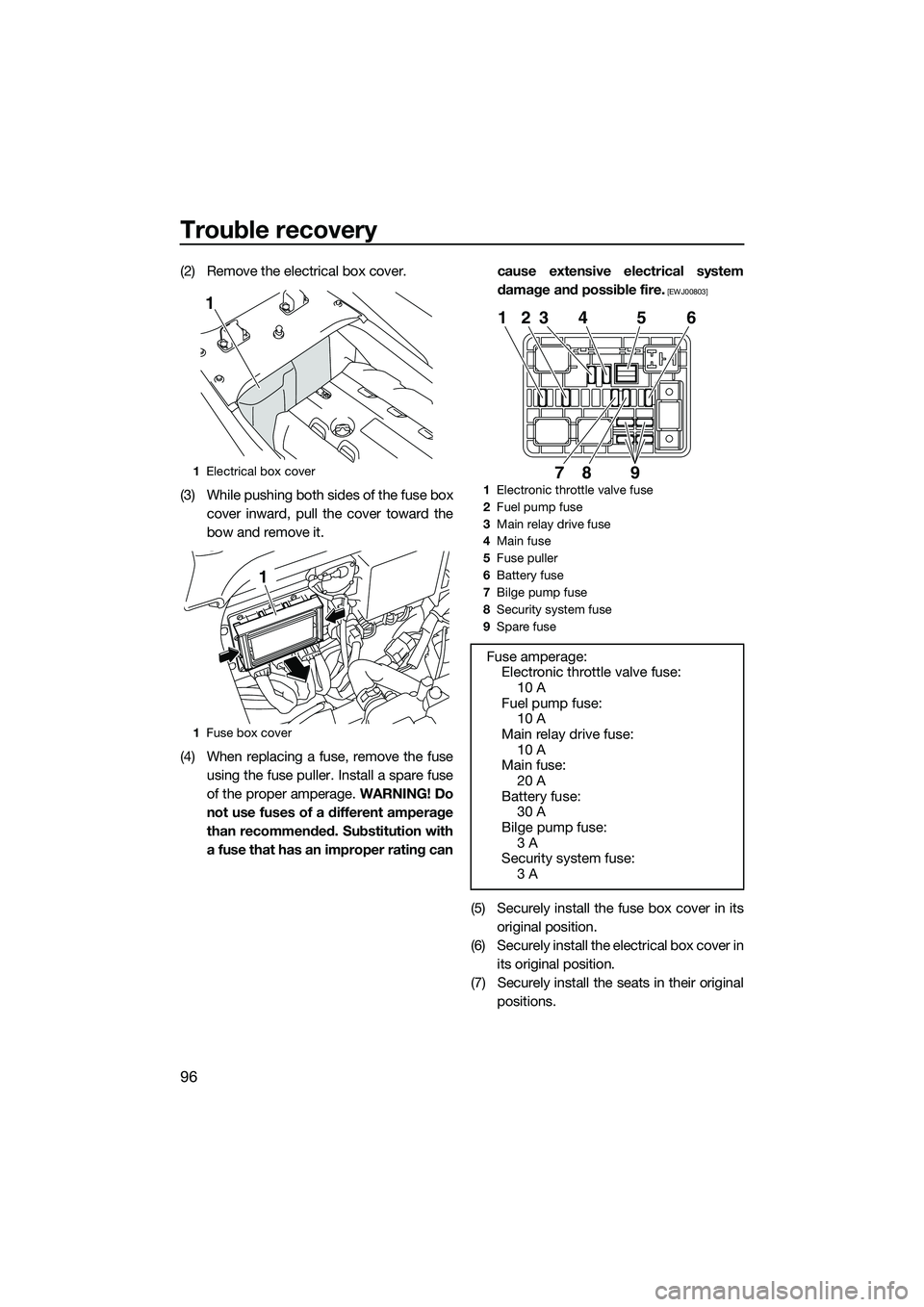
Trouble recovery
96
(2) Remove the electrical box cover.
(3) While pushing both sides of the fuse boxcover inward, pull the cover toward the
bow and remove it.
(4) When replacing a fuse, remove the fuse using the fuse puller. Install a spare fuse
of the proper amperage. WARNING! Do
not use fuses of a different amperage
than recommended. Substitution with
a fuse that has an improper rating can cause extensive electrical system
damage and possible fire.
[EWJ00803]
(5) Securely install the fuse box cover in its
original position.
(6) Securely install the electrical box cover in its original position.
(7) Securely install the seats in their original positions.
1Electrical box cover
1 Fuse box cover
1
1
1Electronic throttle valve fuse
2 Fuel pump fuse
3 Main relay drive fuse
4 Main fuse
5 Fuse puller
6 Battery fuse
7 Bilge pump fuse
8 Security system fuse
9 Spare fuse
Fuse amperage:
Electronic throttle valve fuse: 10 A
Fuel pump fuse: 10 A
Main relay drive fuse:
10 A
Main fuse: 20 A
Battery fuse: 30 A
Bilge pump fuse:
3 A
Security system fuse: 3 A
1
9
23 4 5 6
87
UF3K71E0.book Page 96 Monday, August 18, 2014 2:54 PM
Page 103 of 106
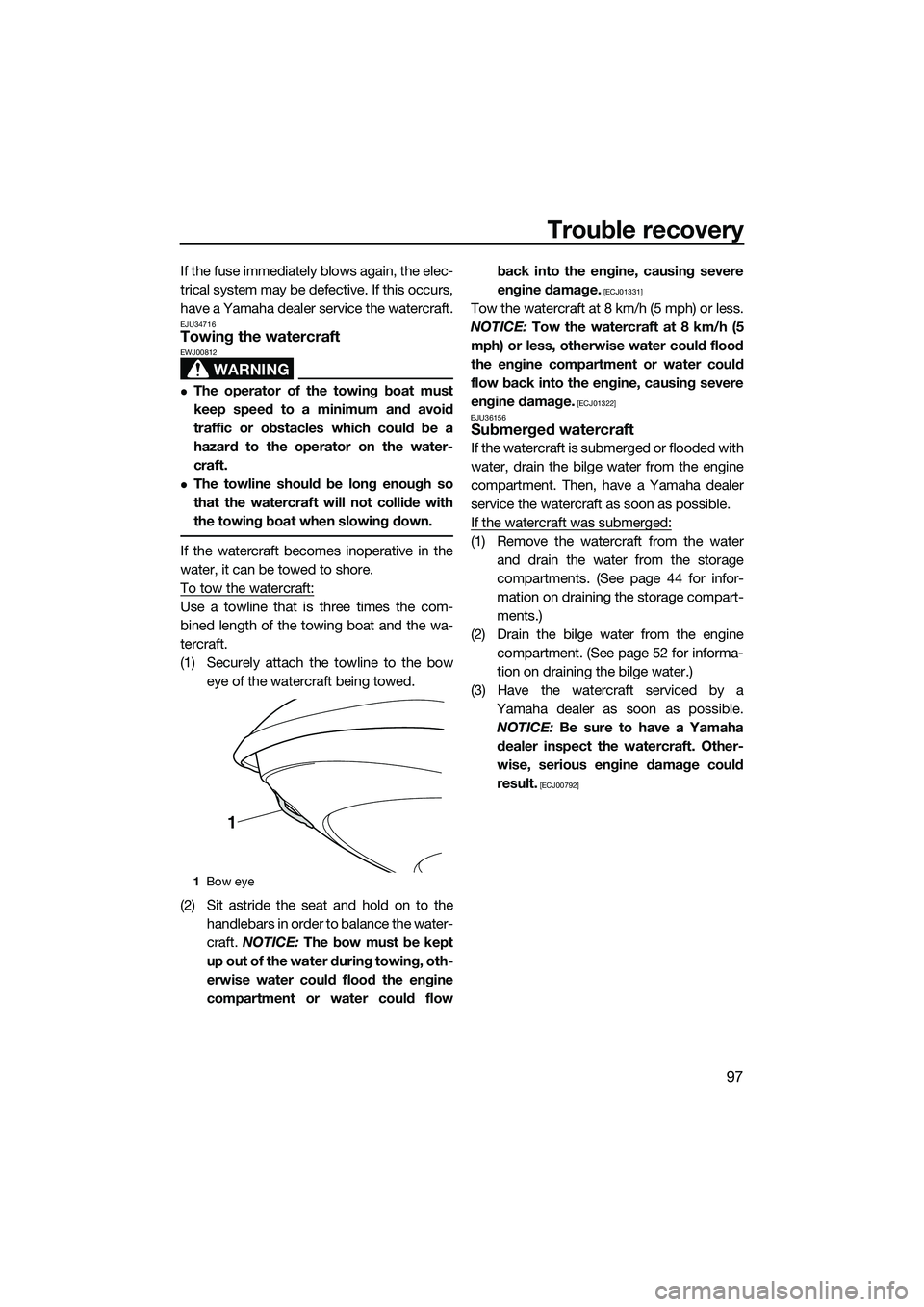
Trouble recovery
97
If the fuse immediately blows again, the elec-
trical system may be defective. If this occurs,
have a Yamaha dealer service the watercraft.
EJU34716Towing the watercraft
WARNING
EWJ00812
The operator of the towing boat must
keep speed to a minimum and avoid
traffic or obstacles which could be a
hazard to the operator on the water-
craft.
The towline should be long enough so
that the watercraft will not collide with
the towing boat when slowing down.
If the watercraft becomes inoperative in the
water, it can be towed to shore.
To tow the watercraft:
Use a towline that is three times the com-
bined length of the towing boat and the wa-
tercraft.
(1) Securely attach the towline to the boweye of the watercraft being towed.
(2) Sit astride the seat and hold on to the handlebars in order to balance the water-
craft. NOTICE: The bow must be kept
up out of the water during towing, oth-
erwise water could flood the engine
compartment or water could flow back into the engine, causing severe
engine damage.
[ECJ01331]
Tow the watercraft at 8 km/h (5 mph) or less.
NOTICE: Tow the watercraft at 8 km/h (5
mph) or less, otherwise water could flood
the engine compartment or water could
flow back into the engine, causing severe
engine damage.
[ECJ01322]
EJU36156
Submerged watercraft
If the watercraft is submerged or flooded with
water, drain the bilge water from the engine
compartment. Then, have a Yamaha dealer
service the watercraft as soon as possible.
If the watercraft was submerged:
(1) Remove the watercraft from the water and drain the water from the storage
compartments. (See page 44 for infor-
mation on draining the storage compart-
ments.)
(2) Drain the bilge water from the engine compartment. (See page 52 for informa-
tion on draining the bilge water.)
(3) Have the watercraft serviced by a Yamaha dealer as soon as possible.
NOTICE: Be sure to have a Yamaha
dealer inspect the watercraft. Other-
wise, serious engine damage could
result.
[ECJ00792]
1 Bow eye
1
UF3K71E0.book Page 97 Monday, August 18, 2014 2:54 PM
Page 104 of 106

98
Index
A
After removing the watercraft from the water ..................................................... 78
B
Battery care.............................................. 80
Battery checks ......................................... 59
Battery, jumping ....................................... 95
Beaching and docking the watercraft ...... 77
Beverage holder ....................................... 46
Bilge water check..................................... 59
Bilge water, draining ................................ 52
Bilge water, draining on land ................... 52
Bilge water, draining on water ................. 53
Boarding alone ......................................... 73
Boarding and starting off from a dock ..... 76
Boarding the watercraft ........................... 72
Boarding with passenger(s) ..................... 73
Bow eye ................................................... 43
Bow storage compartment ...................... 44
Builder’s plate ............................................ 2
C
Capsized watercraft ................................. 76
Check engine warning ............................. 39
Cleaning ................................................... 83
Cleaning the watercraft ............................ 80
Cleat ......................................................... 43
Cooling water pilot outlet check .............. 65
Cooling water pilot outlets ....................... 30
Craft Identification Number (CIN)............... 1
Cruising limitations................................... 12
D
Dual analog meter unit ............................. 36
Dual analog meter unit check .................. 65
E
Emergency procedures ............................ 94
Engine break-in ........................................ 55
Engine compartment check ..................... 58
Engine cover, removing and installing ..... 85
Engine idling speed check ....................... 66
Engine oil ................................................. 51
Engine oil and oil filter .............................. 89
Engine oil level check............................... 59
Engine oil requirements ........................... 51
Engine overheat warning ......................... 39
Engine serial number ................................. 1 Engine shut-off cord (lanyard) check ....... 63
Engine shut-off switch ............................. 28
Engine stop switch ................................... 28
Engine unit check ..................................... 59
Enjoy your watercraft responsibly ............ 20
Equipment ................................................ 41
F
Fire extinguisher check ............................ 64
Fire extinguisher holder and cover........... 47
Fire extinguisher holder, cover, and
band checks ......................................... 64
Flushing the cooling water passages....... 79
Fuel .......................................................... 49
Fuel level check........................................ 58
Fuel level meter ........................................ 38
Fuel level warning..................................... 38
Fuel requirements .................................... 49
Fuel system checks ................................. 58
Fuses, replacing ....................................... 95
G
Getting to know your watercraft .............. 67
Glossary, watercraft ................................. 21
Glove compartment ................................. 45
H
Handgrips................................................. 42
Hazard information................................... 16
Hood check .............................................. 65
Hour meter/voltmeter ............................... 37
Hull and deck check ................................ 64
I
Identification numbers ............................... 1
Information display................................... 37
J
Jet intake and impeller, cleaning.............. 94
Jet intake checks ..................................... 64
Jumper cables, connecting ...................... 95
L
Labels, important ....................................... 4
Labels, other .............................................. 9
Labels, warning .......................................... 5
Launching the watercraft ......................... 68
Learning to operate your watercraft......... 67
Leaving the watercraft.............................. 69
Limitations on who may operate the watercraft .............................................. 11
UF3K71E0.book Page 98 Monday, August 18, 2014 2:54 PM
 1
1 2
2 3
3 4
4 5
5 6
6 7
7 8
8 9
9 10
10 11
11 12
12 13
13 14
14 15
15 16
16 17
17 18
18 19
19 20
20 21
21 22
22 23
23 24
24 25
25 26
26 27
27 28
28 29
29 30
30 31
31 32
32 33
33 34
34 35
35 36
36 37
37 38
38 39
39 40
40 41
41 42
42 43
43 44
44 45
45 46
46 47
47 48
48 49
49 50
50 51
51 52
52 53
53 54
54 55
55 56
56 57
57 58
58 59
59 60
60 61
61 62
62 63
63 64
64 65
65 66
66 67
67 68
68 69
69 70
70 71
71 72
72 73
73 74
74 75
75 76
76 77
77 78
78 79
79 80
80 81
81 82
82 83
83 84
84 85
85 86
86 87
87 88
88 89
89 90
90 91
91 92
92 93
93 94
94 95
95 96
96 97
97 98
98 99
99 100
100 101
101 102
102 103
103 104
104 105
105






